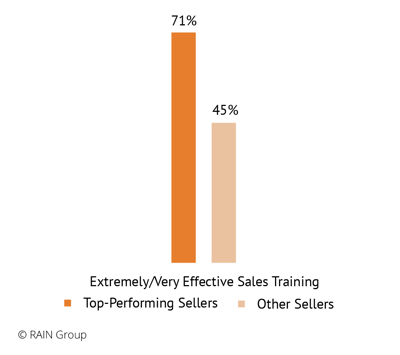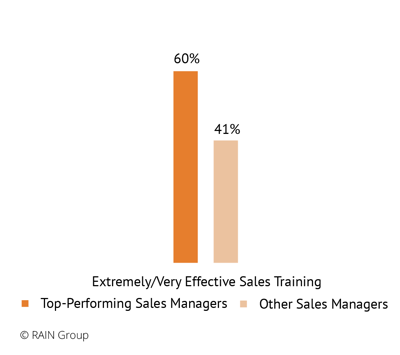Sales training has reached an inflection point. The typical approach to tailoring and delivering sales training courses is failing to meet the needs of modern learners and organizations.
Companies are spending billions of dollars a year, yet 85% to 90% of sales training fails to deliver desired results.
It's a hard truth that significant time, money, and effort is wasted on corporate training each year. Subpar training programs fail to change habits, enhance skills, or create significant ROI. Think about the training you’ve invested in over the years. How effective has it truly been?
More importantly, when it has been effective, why did it work? What are the secrets to designing an enablement program that resonates with sellers and drives results for your organization?
How to Improve Sales Training
- Where Does Sales Training Fall Short?
- Why Does Sales Training Fail?
- How to Build an Effective Sales Training Program
- Sales Training Techniques for New Trainers
- Best Sales Training Topics to Build Skills
- 6 Sales Training Ideas to Keep Training Fresh
- Turning a Corner on Sales Training

Create a sales education system for your organization with this complimentary guide
Plan, execute, and reinforce sales training programs that boost your team's capabilities and drive results.
Where Does Sales Training Fall Short?
Here are some statistics on the shocking failure of traditional training:
- 70% of the information B2B sales reps learn is forgotten within a week of training (Gartner)
- 90% of the new skills learned from corporate training are lost within a year (Human Performance)
- An estimated 90% of training expenditures don't result in improved performance (International Journal of Training and Development)
- Only 21% to 25% of executives report their company's training effectively prepares employees to drive business performance (McKinsey)
- 33% of leaders say their organization's learning strategy and business goals are aligned to a high extent, and only 16% say they are aligned to a very high extent (CTDO Magazine)
- Only 38% of managers believe training programs meet their learners' needs (ATD)
Yet, at the same time, it turns out that most Top Performers do receive effective sales training, reporting so at significantly higher rates than other sellers.
Sales Training Effectiveness
|
|
|
- 71% of Top-Performing Sellers report receiving extremely or very effective sales training
- 60% of Top-Performing Sales Managers report receiving extremely or very effective sales training
Which begs the question: How can you ensure your sales team gets effective sales training?
Effective sales training goes beyond traditional approaches. We've found that today's top-tier programs are:
- Crafted to drive business results (starting with defining the results you want to help achieve)
- Built for adult learners and strategically delivered to drive retention and application
- Designed to support sellers with ongoing coaching and enable organizations to realize results over the long-term
I’ll dig into all three of these areas—part of what we call Execution Assurance—later, but I want to call attention here to the learners. Who are the modern learners frequently overlooked in traditional sales training? How do their learning preferences differ from learners of the past?
Today’s sales training participants are dominated by Millennials and Gen Xers, with plenty of Gen Zers and Boomers in the mix. But across generations, what we’re seeing is that modern learners don’t want to sit for hours being lectured to—whether the training is onsite or virtual. Furthermore, sellers and sales managers have a low tolerance for training that’s not directly applicable to their needs, which means they’ll disengage when training misses the mark.
Modern learners want training that is:
- Immediately accessible and mobile
- An experience, not a presentation
- Open to the input of the learners, not just the experts
- Personalized to their situation and circumstances
- Easily applied to their specific role
For today’s sales training to be effective, it must meet sellers and sales managers where they are.
Why Does Sales Training Fail?
When sales training is ineffective (and much of it is, as highlighted earlier) you’re not going to see your desired results. Ineffective training won’t drive behavior change in sellers.
Trainers and facilitators may share knowledge, but that matters little if your sellers don't retain what they’ve learned and apply those skills in actual selling situations.
If sales training lacks accountability, isn’t tailored for the cohort, or isn’t retained, it won’t be effective. Fortunately, each of these issues can be resolved.
1. Lack of accountability
If sellers aren’t held accountable for follow through on their goals and action plans, they're less likely to do so. Instead, enable and empower sales managers to provide the coaching and support required to keep their teams accountable.
Without leadership buy-in, sellers revert to old habits and are less likely to integrate learning into their ongoing selling activities.
Driving accountability also means adopting an evaluation process. Implemented in the right way, sales performance evaluation analytics can be a source of significant competitive advantage. In fact, 67% more best-in-class companies have implemented sales analytics compared with lower performing organizations, according to Aberdeen Group's Reaching Sales Quotas More Consistently.
Evaluation also allows for continuous improvement well beyond training sessions. When organizations monitor progress, they give themselves the ability to measure the effects of sales training, remove ineffective strategies, and roll out better ones. Plus, the insights gained from evaluation improve future training, decreasing learning curves and even improving your seller onboarding process.
2. Lack of customization
Adult learners have little patience for generic training that’s not tailored to their market, industry, customers, solutions, role, and specific selling situations. Invest the time and resources to customize training so it’s relevant to sellers and helps them address selling challenges. Irrelevant training won’t get adopted and won’t generate results.
3. Lack of retention
Go beyond knowledge transfer. Instead, show sellers how to apply what they’re learning to their actual selling situations. Application exercises, a regular and ongoing coaching cadence, and repetition of training content are all ways to boost retention and ensure training is actually applied.
How to Build an Effective Sales Training Program
At RAIN Group, we believe that the best sales training is built on three pillars: Craft, Deliver, and Enable. We call this the Execution Assurance Framework.
Execution Assurance Framework
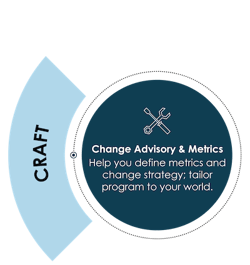 |
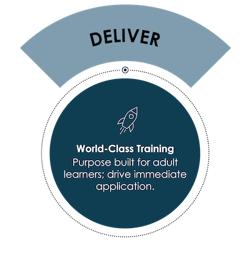 |
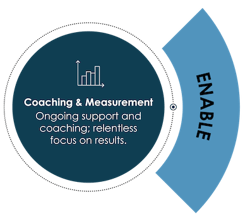 |
Craft
During the craft phase, first consider the business results and metrics you’re seeking to drive and then develop a change strategy to achieve them. Define and agree on the measures by which the success of the initiative will be assessed.
Next, develop a communication plan that clearly articulates expectations for all parties. Many transformation initiatives fail because expectations was not clear and not frequently shared.
Prior to delivery, the training must be perfectly aligned with your organization’s industry, customers, and selling environment. Barriers to achieving top performance should be identified.
Finally, the training curriculum and programs should then be specifically tailored to drive the desired change.
When it comes to crafting sales training, consider the following questions, among others:
- Which sales metrics are more likely to drive success?
- What are your organizational goals?
- What sales roles will be undergoing training?
- What results are you looking to achieve with training?
- What sales training topics are most relevant for your organization?
- Who will carry out the training?
- How will training be reinforced?
- How will you monitor progress and results?
- What is the desired timeline for training?
- How will leadership be involved in training and reinforcement?
- Are your sales managers willing and able to coach sellers?
- What are your expectations for sellers undergoing training?
- How will you keep training interactive and engaging?
- How will the training tie into existing selling activities?
- How is the training relevant for your industry?
Deliver
Sales training delivery should be:
- Modular: Focused, standalone units (modules) of instruction that can be organized into curricula specific to learners’ and the organization’s needs
- Multi-modal: Available in a variety of modalities, such as instructor-led (onsite and virtual), train the trainer, and licensing, and formats, such as micro-learning, video, and so on
- Purpose-built for the modern learner: Practical, interactive, and impactful
In other words, sellers need training they can apply immediately to achieve results. This means the training needs to ensure the development, adoption, and implementation of new skills.
For example, pre-work in advance of training sessions may include some combination of micro-learning, short videos, and interactive exercises. This would be followed by classroom sessions delivered virtually or in person, and which focus on practice, application, and coaching feedback. Don’t think lectures; think hands-on learning.
To learn more about our approach to training, watch the video below.

Enable
A leader-led transformation—change management—is enabled through manager training and a coach-the-coach process.
Sales leaders are equipped with the skills and tools to motivate, focus, and ensure their sellers implement the new approach. A regular, ongoing rhythm of action-oriented coaching allows sales managers to provide direct feedback to sellers, reinforces the skills and knowledge learned during training, and holds sellers accountable to execute at high levels.
Reinforcement techniques include:
- Coaching
- Spaced repetition
- Ongoing access to a training library and tools
- Emailed scenarios to reinforce content or skills
- Embedded technology
- AI roleplay and simulation tools
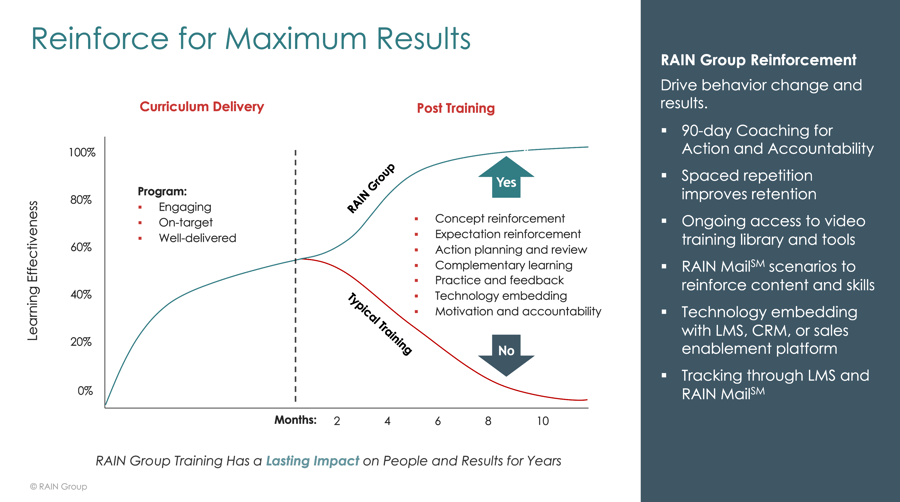
Sales teams build confidence week by week. Progress is monitored with ongoing measurement and reporting on KPIs.
The result of this approach is that the training gets adopted, change happens, and business results get delivered: execution is assured.
Sales Training Techniques for New Trainers
If your enablement team is new to delivering training, you can still build an impactful initiative. Here are just a few ways to get started:
- Deliver focused blocks of training modules: Too much training is theoretical, meandering, and impractical. Sellers have a low tolerance for irrelevant, unfocused training. Instead, deliver modular blocks of learning focused on a specific area and tailored to your team’s selling situations.
- Create customized content: Avoid generic training content. Instead, customize case studies, examples, tools, playbooks, and job aids to make the training directly applicable to the sellers’ industry, company, offerings, and selling situations.
- Create engaging assignments: Assignments such as roleplaying scenarios, demonstrations, and practice proposal presentations can drive post-training reinforcement while simultaneously providing opportunities for coaching.
- Use accountability partners: Have sellers pair up with a partner with whom they’ll share their priorities and do progress check-ins on a weekly basis. Research has shown that being accountable to another person increases the chances of success.
Learn more about these and other sales training techniques.
Best Sales Training Topics to Build Skills
Training fails when topics aren’t relevant to your team, or when you try to cover too much at once. Identifying areas of improvement based on current capabilities is a critical part of crafting your training initiatives.
Below are just a few of the areas sellers often fall short. Consider adding one or more of these topics to your sales training initiatives.
1. Leading a Thorough Needs Discovery
You might think your sellers have this core capability covered, but only 26% of buyers say sellers lead a thorough needs discovery. Training on leading an effective needs discovery process helps sellers craft solutions that deliver value to the buyer.
2. Overcoming Objections
If sellers can’t handle buyer objections with poise, they’ll lose sales. Consultative sales training helps sellers practice appropriate responses to the four types of objections. When they’re prepared, sellers are more likely to overcome objections and move the sale forward to a successful outcome.
3. Qualifying the Sale
Sellers frequently make tough decisions about which sales opportunities deserve their time and attention. In many cases, they spend more time on unqualified opportunities than they should.
Having a process to rapidly qualify a sale allows sellers to separate the opportunities that warrant further pursuit from those that don’t.
4. Winning Sales Opportunities
The #1 skill of Top-Performing Sales Organizations is the ability to drive and win sales opportunities. These organizations have a repeatable process to consistently close deals successfully.
If you can train sellers to adopt proven processes for their own opportunities, they’ll win more. Tactics and tools such as sales opportunity planners and Win Labs can help codify a unified methodology for your team.
5. Making a Powerful Impact and ROI Case
Sellers can close more sales when they’re able to quantify the impacts of their solution and make a strong business case to buyers.
Teams often struggle with making an effective impact case. Often, this is because they’re not clearly communicating value or aren’t going far enough to uncover buyer needs.
6. Growing Strategic and Key Accounts
Top Performers in Strategic Account Management are 80% more likely to have a mature process for strategic account management, including strong processes to build account plans, identify value, and hold teams accountable.
7. Dealing with Common Buyer Negotiation Tactics
Sellers need to know how to respond to common negotiation tactics buyers use. Training can help sellers recognize the different types of buyer tactics and practice an effective response.
8. Maximizing Motivation and Productivity
Motivation and personal effectiveness are hallmarks of top performers. Indeed, our research found Top-Performing Sellers are more likely to be highly rated across nine major productivity areas compared to other sellers. Productivity training helps sellers and sales managers use their time effectively and maximize motivation to achieve the best results.
9. Building Pipeline with Sales Prospecting
The best sales prospectors set 2.7x more meetings, meet their sales goals, and achieve higher win rates than the rest. Prospecting training gives sellers the tools, techniques, and repeatable processes to build strong pipelines.
10. Train the Trainer: A Combined Sales Training Approach
If you’re using in-house sales trainers and facilitators, training and certifying them in seller education helps build the foundation for your ongoing enablement initiatives.
For example, in RAIN Group’s Train the Trainer process, trainers not only learn a world-class sales methodology, but also earn the certification to deliver that training to the organization’s teams. Certification ensures trainers are proficient in training outcomes, preparation, delivery approach, and management.
RAIN Group’s Train the Trainer process includes four key elements:
- Setup and Kickoff: Trainers are provided with self-study lessons, video walkthroughs, best practices, run sheets, facilitator notes, and other resources to set the table for success.
- Study and Prepare: Trainers study learning modules, previous training deliveries, and other resources while working with a master facilitator to prepare for their own delivery.
- Observe and Certify: Trainers are certified after successfully delivering an internal session which is reviewed, scored, and debriefed by a master facilitator.
- Support and Elevate: Trainers receive coaching on facilitation, which includes pre- and post- review sessions and an ongoing partnership to improve quality over time.
Read more about these and other sales training topics. >>
6 Sales Training Ideas to Keep Your Training Fresh
If you’ve been running training and enablement initiatives for some time, it can be easy for sellers to stagnate, thinking that they’ve already learned what they need to thrive.
Move your sellers out of their comfort zone and into the learning zone by offering impactful training they’ll retain and use on the job.
Here’s a sampling of ideas you can incorporate into your training to keep it fresh and impactful.
1. Assess Sales Skills in a Self-Assessment
Allow sellers to take a sales skills self-assessment to honestly assess their selling capabilities. Which skills can be strengthened? Which are important to the seller’s success? To be effective, be sure to assess the capabilities key to being a Top-Performing Seller.
2. Build a Goal and Action Plan
Keep sellers on track and focused on the activities that'll allow them to achieve their goals by encouraging them to create their own goals and action plans.
Our five-step goal-setting worksheet can be used by sellers to build their plan during the training session and as a point of follow up in subsequent coaching sessions.
3. Use a Sales Conversation Planner
Have sellers use a sales conversation planner to prepare for important buyer conversations. A completed conversation planner prepares sellers to get the best possible outcomes from their sales conversations with buyers.
4. Practice a Proposal Presentation
Sellers record themselves doing a practice delivery of a proposal and then get feedback from colleagues or a coach. In doing so, they gain perspective on the strengths and weaknesses of the presentation. They can also test out different openings, closings, or any presentation component before trying it in front of actual buyers.
5. Practice a Simulated Sales Negotiation
An online simulated sales negotiation gives sellers the opportunity to practice their negotiation skills based on real negotiation scenarios. This gives sellers experience in responding to common tactics, handling objections, and trading for value without dropping price in a vacuum.
6. Complete a Prospecting Meeting Calculator
Give sellers a prospecting meeting calculator to determine how many new meetings they need to set on average each week to meet their revenue goals. Walk through examples specific to your business so sellers can see how improving their pipeline and conversion rates can have a big impact on results.
For more sales training ideas, read 30 Sales Training Ideas for Top-Performing Teams.
Turning a Corner on Sales Training
The longtime approach of information-heavy, one-size-fits-all sales training doesn’t effectively prepare sellers to succeed in their roles.
Instead, training must be designed to match learners. Disengagement and lack of adoption can undermine training, but both are signs that more can be done to secure seller buy-in.
Running a successful sales training initiative is possible. It takes a well-defined process of planning, execution, and reinforcement to secure lasting behavior change for your sellers.






